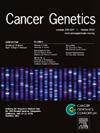10.利用 FUSOR 将融合调用标准化为可计算格式,用于下游临床评估
IF 1.4
4区 医学
Q4 GENETICS & HEREDITY
引用次数: 0
摘要
基因融合是指两个或两个以上的基因相互作用,导致基因产物的异常表达,基因融合事件的检测在临床诊断中起着关键作用。虽然测序技术的进步提高了基因融合数据的可用性,但在临床环境中解释这些知识的方式还存在局限性。具体来说,目前的标准并不精确,无法体现从生物标本中观察到的基因融合的复杂性。为了应对这一挑战,来自 VICC、CGC 和其他临床基因组学团体的专家们开发了一个用于描述融合事件的共识性统一框架。我们开发了 FUSOR 软件包,这是一个 Python 库,其中包含建模和验证工具,用于实现基因融合数据的这一标准。我们通过开发翻译模块 (http://tinyurl.com/FUSOR-Translator) 测试了 FUSOR 在患者样本数据上的使用情况,该模块可标准化来自 CICERO 和 Arriba 等八种广泛使用的融合检测算法的融合调用,以及来自 AACR Project GENIE 队列的融合调用。我们使用 FUSOR 评估了 VICC 基因融合规范的应用情况,以评价该规范在表示融合变异调用方面的完整性。我们展示了如何将该工具应用于真实世界的数据,从而发现新生规范中的不足,包括使用 HUGO 基因命名委员会未涵盖的基因概念,以及改进化验和分类融合概念之间的证据一致性。最后,我们将介绍 FUSOR 工具在临床变异体整理工作流中的应用。本文章由计算机程序翻译,如有差异,请以英文原文为准。
10. Standardizing fusion calls in a computable format with FUSOR for downstream clinical assessment
The detection of gene fusion events, in which two or more genes interact to drive aberrant expression of a gene product, plays a key role in clinical diagnostics. Although advances in sequencing technology have strengthened gene fusion data availability, there are limitations in the way such knowledge is interpreted in a clinical context. Specifically, current standards are imprecise for representing the complexity of fusions that are observed from biological specimens. To address this challenge, experts from VICC, CGC, and other clinical genomics communities developed a consensus, unified framework for the description of fusion events. We developed the FUSOR package, a Python library containing modeling and validation tools that implements this standard for use with gene fusion data.
We tested use of FUSOR on patient sample data through development of a Translator module (http://tinyurl.com/FUSOR-Translator) that standardizes fusion calls from eight widely-used fusion detection algorithms including CICERO and Arriba and fusion calls from the AACR Project GENIE cohort. We assessed application of the VICC Gene Fusion Specification using FUSOR to evaluate the completeness of the specification for representing fusion variant calls. We demonstrate how application of the tool to real-world data identified gaps in the nascent specification, including the use of gene concepts not covered by the HUGO Gene Nomenclature committee and the improved alignment of evidence between assayed and categorical fusion concepts, that we were able to fill to improve the standard. We conclude with applications of the FUSOR tool for use with clinical variant curation workflows.
求助全文
通过发布文献求助,成功后即可免费获取论文全文。
去求助
来源期刊

Cancer Genetics
ONCOLOGY-GENETICS & HEREDITY
CiteScore
3.20
自引率
5.30%
发文量
167
审稿时长
27 days
期刊介绍:
The aim of Cancer Genetics is to publish high quality scientific papers on the cellular, genetic and molecular aspects of cancer, including cancer predisposition and clinical diagnostic applications. Specific areas of interest include descriptions of new chromosomal, molecular or epigenetic alterations in benign and malignant diseases; novel laboratory approaches for identification and characterization of chromosomal rearrangements or genomic alterations in cancer cells; correlation of genetic changes with pathology and clinical presentation; and the molecular genetics of cancer predisposition. To reach a basic science and clinical multidisciplinary audience, we welcome original full-length articles, reviews, meeting summaries, brief reports, and letters to the editor.
 求助内容:
求助内容: 应助结果提醒方式:
应助结果提醒方式:


